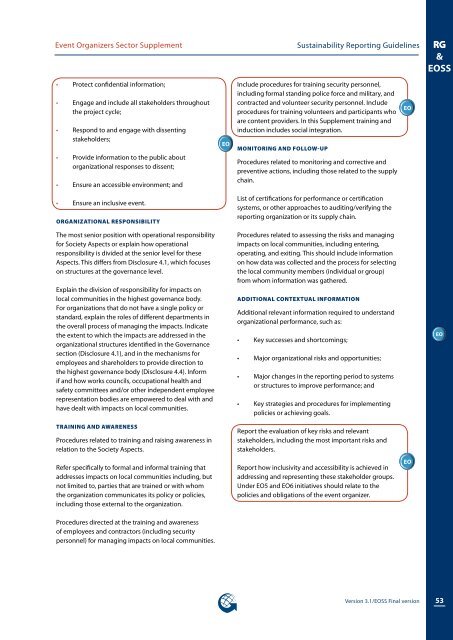Event Organizers Sector Supplement - Global Reporting Initiative
Event Organizers Sector Supplement - Global Reporting Initiative
Event Organizers Sector Supplement - Global Reporting Initiative
You also want an ePaper? Increase the reach of your titles
YUMPU automatically turns print PDFs into web optimized ePapers that Google loves.
<strong>Event</strong> <strong>Organizers</strong> <strong>Sector</strong> <strong>Supplement</strong><br />
Sustainability <strong>Reporting</strong> Guidelines<br />
RG<br />
&<br />
EOSS<br />
• Protect confidential information;<br />
• Engage and include all stakeholders throughout<br />
the project cycle;<br />
• Respond to and engage with dissenting<br />
stakeholders;<br />
• Provide information to the public about<br />
organizational responses to dissent;<br />
• Ensure an accessible environment; and<br />
EO<br />
Include procedures for training security personnel,<br />
including formal standing police force and military, and<br />
contracted and volunteer security personnel. Include<br />
procedures for training volunteers and participants who<br />
are content providers. In this <strong>Supplement</strong> training and<br />
induction includes social integration.<br />
Monitoring and Follow-Up<br />
Procedures related to monitoring and corrective and<br />
preventive actions, including those related to the supply<br />
chain.<br />
EO<br />
• Ensure an inclusive event.<br />
Organizational responsibility<br />
List of certifications for performance or certification<br />
systems, or other approaches to auditing/verifying the<br />
reporting organization or its supply chain.<br />
The most senior position with operational responsibility<br />
for Society Aspects or explain how operational<br />
responsibility is divided at the senior level for these<br />
Aspects. This differs from Disclosure 4.1, which focuses<br />
on structures at the governance level.<br />
Explain the division of responsibility for impacts on<br />
local communities in the highest governance body.<br />
For organizations that do not have a single policy or<br />
standard, explain the roles of different departments in<br />
the overall process of managing the impacts. Indicate<br />
the extent to which the impacts are addressed in the<br />
organizational structures identified in the Governance<br />
section (Disclosure 4.1), and in the mechanisms for<br />
employees and shareholders to provide direction to<br />
the highest governance body (Disclosure 4.4). Inform<br />
if and how works councils, occupational health and<br />
safety committees and/or other independent employee<br />
representation bodies are empowered to deal with and<br />
have dealt with impacts on local communities.<br />
Procedures related to assessing the risks and managing<br />
impacts on local communities, including entering,<br />
operating, and exiting. This should include information<br />
on how data was collected and the process for selecting<br />
the local community members (individual or group)<br />
from whom information was gathered.<br />
Additional Contextual Information<br />
Additional relevant information required to understand<br />
organizational performance, such as:<br />
• Key successes and shortcomings;<br />
• Major organizational risks and opportunities;<br />
• Major changes in the reporting period to systems<br />
or structures to improve performance; and<br />
• Key strategies and procedures for implementing<br />
policies or achieving goals.<br />
EO<br />
Training and awareness<br />
Procedures related to training and raising awareness in<br />
relation to the Society Aspects.<br />
Refer specifically to formal and informal training that<br />
addresses impacts on local communities including, but<br />
not limited to, parties that are trained or with whom<br />
the organization communicates its policy or policies,<br />
including those external to the organization.<br />
Report the evaluation of key risks and relevant<br />
stakeholders, including the most important risks and<br />
stakeholders.<br />
Report how inclusivity and accessibility is achieved in<br />
addressing and representing these stakeholder groups.<br />
Under EO5 and EO6 initiatives should relate to the<br />
policies and obligations of the event organizer.<br />
EO<br />
Procedures directed at the training and awareness<br />
of employees and contractors (including security<br />
personnel) for managing impacts on local communities.<br />
Version 3.1/EOSS Final version<br />
53

















